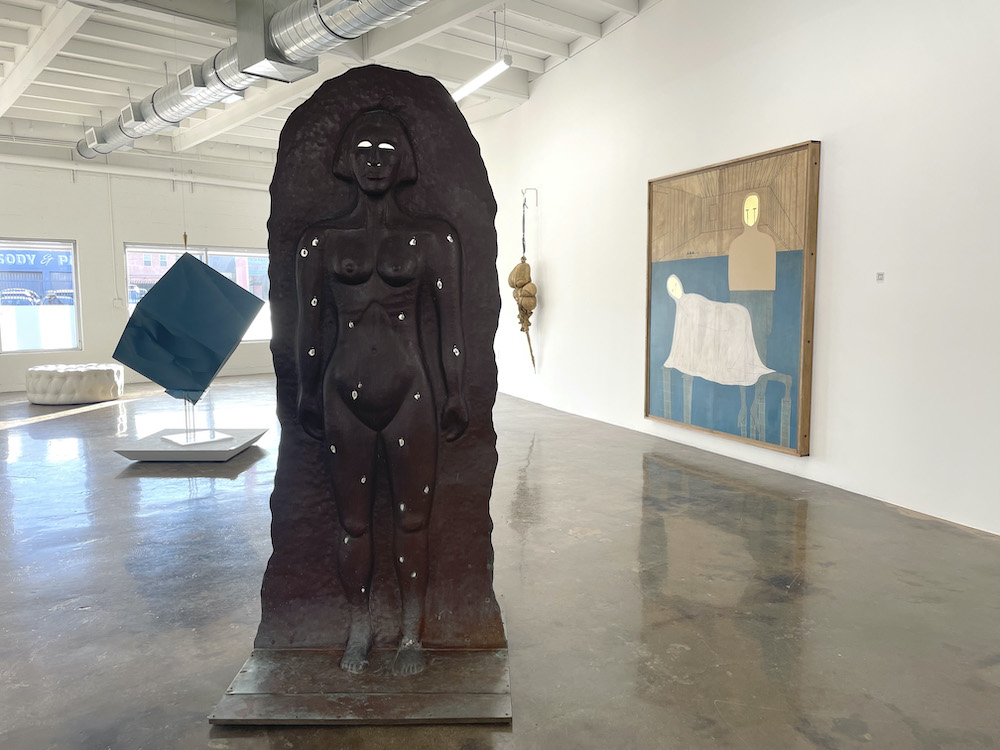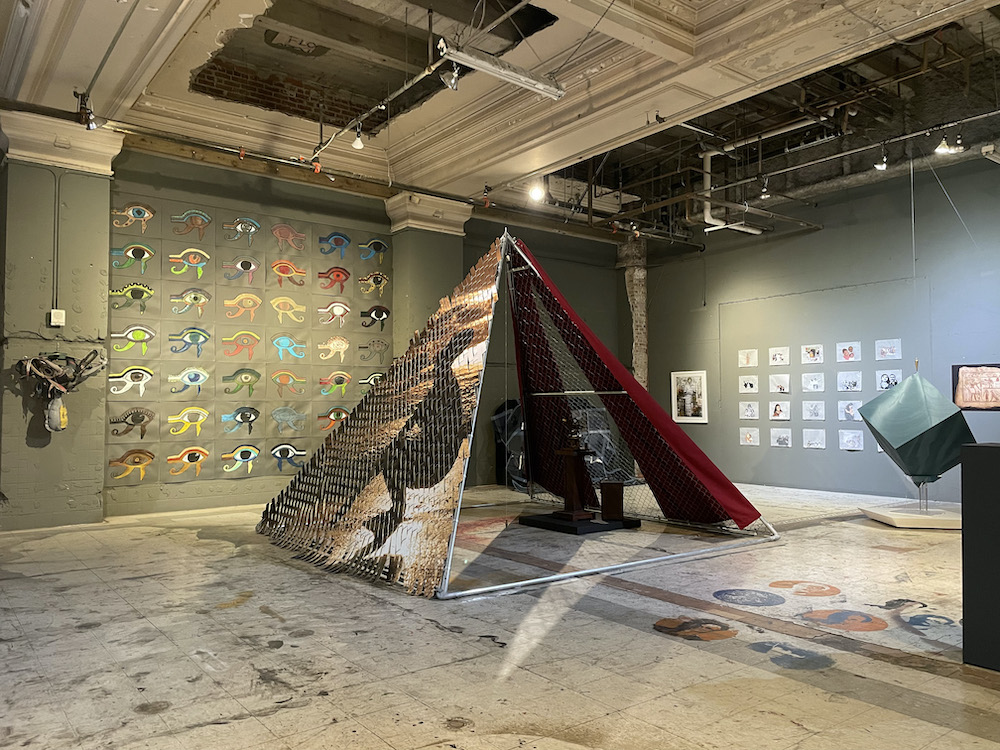The Getty Villa’s exhibition, “Nubia: Jewels of Ancient Sudan,” offers a stunning display of jewelry and items of personal adornment excavated from burials of royalty and aristocratic individuals from a region that spans what is today southern Egypt and northern Sudan. Almost 3000 years of ancient history are presented in exquisite examples of metalwork in silver, bronze and mostly gold, reflecting the abundant and coveted gold mines of Nubia.
At one point, I found myself in front of a gypsum relief of what appeared to be hieroglyphics carved into a stone temple wall. Closer inspection revealed it was LA artist lauren halsey’s image of an urban building façade, plastered with ads in English and Spanish for cash loans and “pupusas y hot-dogs,” and graffiti declaring the space occupied by the viewer as “our hood.”
This subversive contemporary artwork’s inclusion in an antiquities museum is thanks to “Adornment | Artifact,” a related curatorial project by Transformative Arts’ co-founder jill moniz. Moniz invited more than 60 artists representing the diverse lineages of the Nubian diaspora in LA to respond to the Villa’s exhibition in five sister exhibitions across the city that celebrate their unique cultural legacies. “These ideas live in us,” said moniz, “and happen to also be part of what makes LA such a vital and vibrant place.”
Inspired, to experience this ambitious project, I decided to visit the other four sites.

Installation shot: “Adornment | Artifact” at Transformative Arts. Photo by Bianca Collins.
Born in Turkey, moniz told me in an interview that she sees art as a “pathway, and a doorway at the same time, to building place for oneself in one’s community.” A foundational understanding that visual literacy helps people build agency and mobility has guided Transformative Arts’ program with vulnerable populations around the world since 2006. “It drives everything I do,” admited moniz. “Art becomes something more when it’s combined with a viewer—or a wearer in the case of adornment—something greater, and more spiritual; a pathway to divinity.”
The “Adornment | Artifact” journey took me from The Getty Villa in Malibu to a pop-up gallery in a retail space at Baldwin Hills Crenshaw Plaza, an important trade route in a primarily Black neighborhood. This installation is “about discovery,” said moniz. Nubian symbols and materials abound, each with its own unique interpretation. I particularly loved Jackson Moniz’ (moniz’ son) gorgeous drawing with pen-and-coffee on paper of “LA Hieroglyphics” in his signature single-line style; Brenna Youngblood’s cosmic Blue Star made with painted mixed media on metal and Dale Davis’ Midnight Basketball Corner Shot, an assemblage commenting on possibility and transformation.
Moniz’ other son, Jules, was the gallery attendant. A soft-spoken young man, he deftly explained that the trade routes from ancient Nubia set up a cultural ownership of materials used in the works on display. “That ownership was something taken during colonialism, stolen and co-opted by museums,” he said. “We have a more democratic, communal vision for these pieces, these items that have been used and repurposed.”
Located in the historically Black neighborhood of West Adams is Terrell Tilford’s Band of Vices gallery, an anchor cultural space that provides a platform for those who have been historically overlooked and marginalized. An Alison Saar sculpture of a life-sized relief of a woman made from metal, material revered sculpturally in ancient Nubia, stole the show in this white-cube space. Viewers were invited to step into this strong female form, which bears scars filled with cowrie shells, a sign of wealth. The piece reclaims and re-articulates a narrative about “what our perceived weaknesses are and aren’t,” said moniz.
Transformative Arts, moniz’ project space smack dab in the heart of downtown LA’s gallery row, is all about community. An ongoing weekly art project during the run of “Adornment | Artifact” invites community members to create an image of an Eye of Horus and proudly display it on the walls surrounding the exhibition, an evolving art installation that will cover the walls by the time the show closes.

Installation shot: “Adornment | Artifact” at Transformative Arts. Photo by Bianca Collins.
Finally, I visited Eastern Projects in Chinatown and met with Rigo Jimenez, a Chicano with old-school sensibilities and a history of nurturing emerging artists. Eastern Projects’ reputation as a space for revolution and change made it the sensible host for work by artists like Timothy Washington, an assemblage artist whose works feature thousands of fragments of found artifacts, and Retna, the street artist whose calligraphy adorning walls all over the world has created a sensation.
“When you go into white institutions and museums, you’re told you don’t know anything: ‘Don’t touch. Don’t engage. Look in reverence. We are the only ones who know the truth,’” said moniz. “But at Baldwin Hills Crenshaw, they’re in a mall. It’s theirs. To watch people realize it is for them is empowering both to us and to them.”


